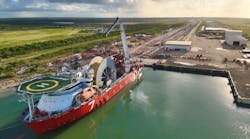Total E&P Congo has awarded Technip an engineering, procurement, and supply contract for the Moho Nord project, the largest development ever in the Republic of Congo.
The Moho Nord project, 75 km (47 mi) offshore Pointe Noire, consists of two developments, Moho Phase 1bis and Moho Nord. This contract is part of the Moho Phase 1bis development. It is a brownfield development consisting of tiebacks to the existing deepwater Alima FPU and the shallow-water N'Kossa platform.
The contract covers the project management, detail engineering, procurement, and supply for the modifications of the Alima FPU, with two new subsea tiebacks.
Technip in Paris will manage the contract, which is scheduled to be completed in the first semester of 2015.
Technip will also assist Total for the offshore construction phase to be spread from 2014 to 2016.
Subsea 7 extends pipelay support for Petrobras
Subsea 7 has won a contract with a value of around $450 million from Petrobras for the operation of the pipelay support vessel (PLSV)Seven Phoenix on a day rate basis for five years, with operations starting in this quarter.
The vessel has operated for Petrobras for several years and is under contract with this client.
The work scope of the contract is similar to that of other PLSVs Subsea 7 currently operates offshore Brazil, and comprises project management, engineering, and installation of flowlines, umbilicals, and equipment supplied by Petrobras.
DOF to moor FPSO off Norway
DOF Subsea Norway has won a contract from Teekay Petrojarl Production AS in Norway for work involving a newbuild FPSO.
The scope of work includes mooring pre-installation, tow-out, and hook-up for Teekay Petrojarl Production's new FPSO to be installed on the BG-operated Knarr field in the Norwegian North Sea.
DOF Subsea Norway will mobilize itsSkandi Skolten vessel for this project, with six additional vessels from its global fleet being utilized in support.
The project will be completed in three phases; the first phase is pre-installation of the complete mooring system consisting of 12 mooring lines taking place in 2013. DOF Subsea has already started with the planning, engineering, and offshore management of the project.
The FPSO will be kept at a fjord on the west coast of Norway when it is delivered in 2014 until the field is ready for the FPSO to be installed later in the year. At that point it will be towed to the location and connected to the pre-laid mooring system.
Chevron turns to WorleyParsons for Buckskin/Moccasin
Chevron U.S.A. Inc. has selected WorleyParsons to provide engineering services for the Buckskin and Moccasin oil and gas production facility in the Lower Tertiary outer continental shelf of the Gulf of Mexico. Buckskin is owned by Chevron, Maersk Oil, Repsol E&P USA Inc., and Samson Offshore LLC. Moccasin is owned in part by Chevron and Samson.
Under the contract, WorleyParsons and its subsea division INTECSEA will execute the pre-front-end engineering design preliminary phase for the deepwater subsea architecture, riser interface, and topside facility design for an oil and gas production semisubmersible.
WorleyParsons will also manage a hull subcontractor to execute the hull preliminary design.
Statoil, ABB to cooperate on long-distance power
Statoil and ABB have agreed to develop solutions for subsea electrical power transmission, distribution, and power conversion for water depths to 3,000 m (9,840 ft) and over long distances.
The agreement is a cost-shared joint industrial program (JIP) led by Statoil on behalf of other participating oil companies, with ABB as the technology developer.
The agreement follows a large subsea electrification study executed jointly by Statoil and ABB during 2012.
"The JIP will develop technologies needed to provide electrical power to subsea pumps, electrical submersible pumps, and subsea gas compressors for projects on the Norwegian continental shelf, in the Gulf of Mexico, and other places around the world," said Karl Johnny Hersvik, Statoil senior vice president for research, development, and innovation.
The technology is intended to enable transmission of electrical power over long distances, important for the development of remote fields including Arctic areas.
The total cost for the program, which has a duration of five years, is $100 million, including ABB funding.
Subsea electrical power distribution enables supply of all electrical loads using a single power cable. This reduces the cost of the electrical system compared to existing solutions that require one dedicated cable for each consumer (pump or compressor).
Cables are a major cost driver for subsea processing systems, and that cost can be reduced with subsea power distribution. The cost reduction depends on distance and required electrical power. For example, in a case with eight consumers and a distance of 200 km (124 mi) from infrastructure, the electrical power distribution solution would reduce capex by more than $500 million, says Statoil.
BC-10 rigless intervention progressing
Doedijins will deliver part of the rigless intervention system for SBM Offshore Malaysia destined for installation at Shell's BC-10 deepwater production facilities offshore Brazil.
The rigless intervention system facilitates replacement of a worn or failed caisson based artificial lift systems used at BC-10. The entire electrical submersible pump/caisson assembly will be recovered to the surface and landed out in an intervention facility. The scope comprises the complete hydraulic drive and control system plus the skidding system for the RIS, all to be certified according to ABS.
Prototype AUV advances deepwater inspection
A research project directed by Lockheed Martin through the US National Energy Technology Laboratory is testing an AUV capable of equipment inspection and monitoring in deepwater. The project recently tested the AUV on structures in the Gulf of Mexico.
The operational concept is to have an AUV autonomously inspect with minimal user input an offshore structure. The user chooses the facility, and specifies how much of the platform is to be inspected using a command and control user interface. The AUV autonomously plans the inspection path around the platform, executes this path to collect sonar data, builds a 3D model of the platform in real-time, and executes change detection to identify anomalies.
Autonomous response guides the vehicle through the mission. The response system provides mission planning, high-level guidance and contingency detection, assessment, and response capabilities for the AUV.
The testing verified the system's ability to build a model of a platform and detect anomalies in an operational environment. This combination of technologies is an improvement over current state-of-the-art offshore inspection capabilities, says NETL.






